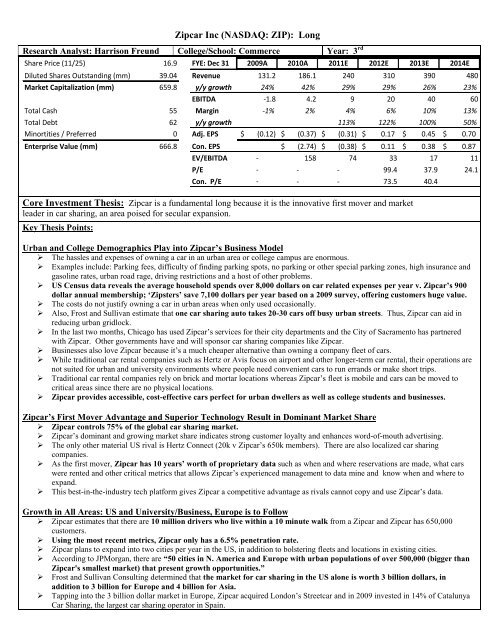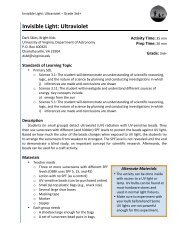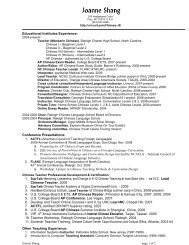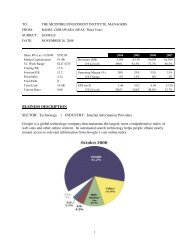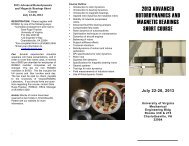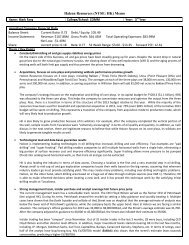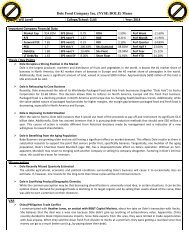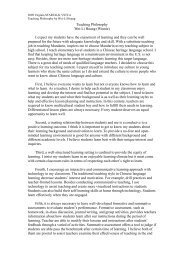You also want an ePaper? Increase the reach of your titles
YUMPU automatically turns print PDFs into web optimized ePapers that Google loves.
Zipcar Inc (NASDAQ: <strong>ZIP</strong>): Long<br />
Research Analyst: Harrison Freund College/School: Commerce Year: 3 rd<br />
Share Price (11/25) 16.9 FYE: Dec 31 2009A 2010A 2011E 2012E 2013E 2014E<br />
Diluted Shares Outstanding (mm) 39.04 Revenue 131.2 186.1 240 310 390 480<br />
Market Capitalization (mm) 659.8 y/y growth 24% 42% 29% 29% 26% 23%<br />
EBITDA -1.8 4.2 9 20 40 60<br />
Total Cash 55 Margin -1% 2% 4% 6% 10% 13%<br />
Total Debt 62 y/y growth 113% 122% 100% 50%<br />
Minortities / Preferred 0 Adj. EPS $ (0.12) $ (0.37) $ (0.31) $ 0.17 $ 0.45 $ 0.70<br />
Enterprise Value (mm) 666.8 Con. EPS $ (2.74) $ (0.38) $ 0.11 $ 0.38 $ 0.87<br />
EV/EBITDA - 158 74 33 17 11<br />
P/E - - - 99.4 37.9 24.1<br />
Con. P/E - - - 73.5 40.4<br />
Core Investment Thesis: Zipcar is a fundamental long because it is the innovative first mover and market<br />
leader in car sharing, an area poised for secular expansion.<br />
Key Thesis Points:<br />
Urban and College Demographics Play into Zipcar‟s Business Model<br />
The hassles and expenses of owning a car in an urban area or college campus are enormous.<br />
Examples include: Parking fees, difficulty of finding parking spots, no parking or other special parking zones, high insurance and<br />
gasoline rates, urban road rage, driving restrictions and a host of other problems.<br />
US Census data reveals the average household spends over 8,000 dollars on car related expenses per year v. Zipcar‟s 900<br />
dollar annual membership; „Zipsters‟ save 7,100 dollars per year based on a 2009 survey, offering customers huge value.<br />
The costs do not justify owning a car in urban areas when only used occasionally.<br />
Also, Frost and Sullivan estimate that one car sharing auto takes 20-30 cars off busy urban streets. Thus, Zipcar can aid in<br />
reducing urban gridlock.<br />
In the last two months, Chicago has used Zipcar‟s services for their city departments and the City of Sacramento has partnered<br />
with Zipcar. Other governments have and will sponsor car sharing companies like Zipcar.<br />
Businesses also love Zipcar because it‟s a much cheaper alternative than owning a company fleet of cars.<br />
While traditional car rental companies such as Hertz or Avis focus on airport and other longer-term car rental, their operations are<br />
not suited for urban and university environments where people need convenient cars to run errands or make short trips.<br />
Traditional car rental companies rely on brick and mortar locations whereas Zipcar‟s fleet is mobile and cars can be moved to<br />
critical areas since there are no physical locations.<br />
Zipcar provides accessible, cost-effective cars perfect for urban dwellers as well as college students and businesses.<br />
Zipcar‟s First Mover Advantage and Superior Technology Result in Dominant Market Share<br />
Zipcar controls 75% of the global car sharing market.<br />
Zipcar‟s dominant and growing market share indicates strong customer loyalty and enhances word-of-mouth advertising.<br />
The only other material US rival is Hertz Connect (20k v Zipcar‟s 650k members). There are also localized car sharing<br />
companies.<br />
As the first mover, Zipcar has 10 years‟ worth of proprietary data such as when and where reservations are made, what cars<br />
were rented and other critical metrics that allows Zipcar‟s experienced management to data mine and know when and where to<br />
expand.<br />
This best-in-the-industry tech platform gives Zipcar a competitive advantage as rivals cannot copy and use Zipcar‟s data.<br />
Growth in All Areas: US and University/Business, Europe is to Follow<br />
Zipcar estimates that there are 10 million drivers who live within a 10 minute walk from a Zipcar and Zipcar has 650,000<br />
customers.<br />
Using the most recent metrics, Zipcar only has a 6.5% penetration rate.<br />
Zipcar plans to expand into two cities per year in the US, in addition to bolstering fleets and locations in existing cities.<br />
According to JPMorgan, there are “50 cities in N. America and Europe with urban populations of over 500,000 (bigger than<br />
Zipcar's smallest market) that present growth opportunities.”<br />
Frost and Sullivan Consulting determined that the market for car sharing in the US alone is worth 3 billion dollars, in<br />
addition to 3 billion for Europe and 4 billion for Asia.<br />
Tapping into the 3 billion dollar market in Europe, Zipcar acquired London‟s Streetcar and in 2009 invested in 14% of Catalunya<br />
Car Sharing, the largest car sharing operator in Spain.
Zipcar Inc (NASDAQ: <strong>ZIP</strong>): Long<br />
These two investments are the springboard into Europe‟s three billion dollar market for car sharing where tight, urban conditions<br />
are more conducive to car sharing.<br />
There is also growth in the University/Business segment, which currently represents 10% of revenues.<br />
Students will become familiar with Zipcar at college and they will continue to use Zipcar in the cities where they move.<br />
Bottom Line: Zipcar is positioned for sustainable growth in both the US and in Europe for the foreseeable future.<br />
High Operating Leverage will Generate High Returns for Patient Investors<br />
Zipcar has high fixed costs in purchasing cars (financed by 60% by an ABS facility) and setting up locations.<br />
However, once Zipcar membership and use rises, the fixed costs will be covered (the company estimates this takes about 3 years)<br />
and additional revenues will have a powerful impact on financials.<br />
Margins will further improve as Zipcar will use an ABS program to purchase cars, utilization rates will improve and high margin<br />
fee revenue will become a larger part of Zipcar‟s topline.<br />
Misperceptions<br />
Due to rapid growth leading to tight margins, the buyside tends to be bearish in their valuation and ratings.<br />
Unit Economics—Not as rosy as sellside/management expectations but it‟s not negative as buyside says.<br />
Zipcar estimates a 86% IRR with leverage, I estimate 8.3% IRR with leverage (see Appendix 2). The buyside predicts a 2% to<br />
negative IRR on unit economics.<br />
Zipcar has already captured the „low hanging fruit‟ and future expansion into less populous cities will be difficult to attain.<br />
The above is false because even in mature, profitable markets (NYC, BOS, DC, SF), the addition of more cars per location and<br />
increased market penetration will result in continued growth. Less populous early-stage markets have the opportunity for tactical<br />
expansion in downtown areas for urban dwellers and businesses.<br />
Analysts think that low cost car sharing companies with societal goals will out-compete Zipcar. However, these non-for-profits<br />
tend to be in smaller cities where public transportation is limited, not in larger cities that Zipcar targets.<br />
Short-term investors see more equity financing and lockup expiration as a negative (see Catalysts Section). These two factors<br />
have no bearing on company fundamentals however.<br />
Still in its infancy, European growth is not priced in as investors focus on US operations.<br />
VAR (see Appendix 1 for VAR)<br />
How It Plays Out/Catalysts<br />
Expansion and growth continue in all sectors having a direct impact on improving the bottom line and multiples.<br />
With more expansion in the works and possible M&A, the company will need to acquire more (equity) financing.<br />
Short term, this dilution will cause shares to dip, but creates a buying opportunity for the long-term investor.<br />
Lockout expires and executives dump shares, creating a buy-in point.<br />
Strategic acquisition by a „traditional‟ car rental rival.<br />
Margins improve and the company will have better unit economics numbers causing the buyside to cover their short positions.<br />
More analyst coverage and once Zipcar proves itself as profitable, the sell-side will switch ratings from neutral to buy.<br />
Risks<br />
Competition heats up: Hertz‟ Connect and Enterprises‟ WeCar offer car sharing in addition to numerous local car sharing hubs.<br />
Inherent risk in M&A might be a speed bump in European expansion.<br />
Valuation is worrisome; Zipcar currently trades at 74X 2011E EBIDTA.<br />
The company has only one quarter with net income and management predicts another net loss in 2011.<br />
Unit economics projections may be incorrect.<br />
Zipcar may be unable to pass on higher gasoline or insurance rates.<br />
Signposts / Follow-Up<br />
Monitor key company metrics such as ending members, new<br />
members added, fleet numbers, retention rates, revenue per car<br />
per day<br />
Make sure Zipcar doesn‟t overleverage itself to fund<br />
expansions<br />
Monitor unit economics trends<br />
Perform basic due diligence; monitor earnings calls and read<br />
quarterly reports/earnings<br />
Check-up on Zipcar‟s European expansion strategy<br />
Company Description<br />
Founded in 2000, Zipcar is the largest car sharing company that<br />
had its IPO in April 2011. Zipcar offers two memberships,<br />
occasional and extra value. Membership fees include the cost of<br />
renting the car along with gas and insurance. After signing up,<br />
each customer receives a Getaway card. Customers reserve cars<br />
through their (smart) phone or internet and use their Getaway<br />
card to unlock the car. Zipcar is established in 16 metropolitan<br />
areas, 250 college campuses, with 650,000 total customers.
Zipcar Inc (NASDAQ: <strong>ZIP</strong>): Long<br />
Appendix 1: Value Added Research<br />
Contact Type Contact Information Key Quotes<br />
Customer Private<br />
“I used to use Zipcar a lot. I really liked it. It was really convenient. Later, the company I<br />
Businessman in New work for gave us a special rate for car rental so I stopped using Zipcar. But if the company<br />
York City<br />
didn‟t give us that deal, I‟d still be using Zipcar.”<br />
Employee Andrew Paez<br />
“Sorry, I can‟t speak about the growth of the company. You have to read the IR portion of<br />
Head of College Sales our website or the SEC filings.”<br />
Customer Joe Agnello<br />
UVA Student<br />
Competitor Becca Van Dyke<br />
Vermont Car Sharing<br />
Company and<br />
Industry Expert<br />
Mark Chase<br />
Director of Business<br />
Development & Planning<br />
Zipcar (2000-2004)<br />
Founding Team of Zipcar<br />
“The MD‟s and associates loved them.” (The Blackstone employees in the Boston Office<br />
used Zipcar to get around town.)<br />
“It‟s a great company.”<br />
“We‟re a non-profit model, Zipcar is for profit.”<br />
“I think Zipcar grew too fast, added too many cars. They‟re doing ok in bigger cities but<br />
haven‟t been profitable.”<br />
“A for-profit model is not successful in smaller cities.”<br />
“Sidney, Australia invested a lot in car sharing and San Francisco did in the US as part of<br />
their transportation.”<br />
“One reason Zipcar isn‟t profitable is that they‟re expanding. High burn rate. Once they stop,<br />
they‟ll grow. Need 500 cars before you start recovering overhead.”<br />
“Zipcar‟s core markets, those are highly profitable. London too, still figuring out.”<br />
“Critical variable for Zipcar is that people are able to live without a car most of the time.”<br />
“Parts of small cities where you can do that. Barriers are more cultural, people feel like they<br />
have to own a car. For Zipcar to work you need a large number of people who don‟t own<br />
cars.”<br />
“Million dollar question, certainly possible for European expansion. Can they execute? All<br />
about local knowledge, so far Zipcar has acquired other companies, gives local expertise.”<br />
“Fits perfectly with off-demand period, residents use nights, weekends, businesses use during<br />
day.”<br />
“Unit economics, beauty is cars are moveable, if a location is doing well, add cars, locations<br />
have strict margin on each car. More cars you have, more you can push utilization. If you<br />
have 3 cars, 2 are out and one is still there, 66% utilization. If there are 20 cars and 19 are<br />
out, utilization is 95%, you can push the margin as you add cars. You want a giant grid so<br />
that if a lot are out, you can still get one. Scale is important for margins.”<br />
Buyside Analyst Private “University and Commercial markets could be really good for the company.”<br />
“In a sense, they are always expanding because the cars have to be recycled every 2 years.<br />
They will always have a really capital intensive business. I just don‟t think the return on<br />
capital of business (i.e. the cash on cash return per car) is good enough to justify this<br />
valuation. But yes, growth will help them. I just don‟t think they can hit a switch and be a<br />
high margin business like a software company.”<br />
Caveat: “I like Zipcar the company and have used their service before as a consumer. It‟s<br />
great. But so are Pandora and Groupon. Just because it‟s a good consumer experience<br />
Competitor Annie Bourdon<br />
Board of Directors San<br />
Francisco City CarShare<br />
Founder of Car Share<br />
Vermont<br />
Channel Checks New York City (a „mature market‟)<br />
doesn‟t mean it will be a great investment.”<br />
“Car sharing is gaining momentum. Growth is a reflection that it‟s effective .”<br />
“Profitability is possible—there are different models for different communities.”<br />
“Lots of towns would benefit, not profitable without density to support large operations, 50k<br />
and under where public transport is limited.”<br />
“SF City CarShare is thriving and financially self-sufficient.”<br />
Obersvations: I went to two Zipcar locations in the midtown area of New York. Zipcar rents space in commerical garages for its cars<br />
throughout the city. There are no signs indicating Zipcars are present; one has to know Zipcar is in the particular location. This<br />
reduces advertising expenditures. One garage attendant in a Central Park South location said all Zipcars were out and one further<br />
down said only two cars out of 9 were in. Granted, it was a summer weekend and probably saw increased demand, but it was<br />
encouraging. (I saw a few Zipcars on city streets too.)<br />
In contrast to the „bare bones‟ Zipcar model, I saw Hertz ads covering an entire subway car. Hertz was advertising easy car rental in<br />
many locations throughout the city, like Zipcar. Hertz promised that there were no sign-up fees, unlike Zipcar. Hertz‟s traditional<br />
advertising may create problems for Zipcar which sticks to cost-effective forms of advertisment such as word-of-mouth advertising<br />
and Facebook.
Zipcar Inc (NASDAQ: <strong>ZIP</strong>): Long<br />
Appendix 2: Unit Econimics and Valuation<br />
Zipcar Unit Economics Analysis<br />
Average Cost -20000<br />
Financing 12000<br />
Year 0 Year 1 Year 2 Year 3<br />
Revenue per Vehicle 24000 24000 24000<br />
Cost per Vehicle (ex dep) -12000 -12000 -12000<br />
Interest Cost (7%) -840 -560 -280<br />
Proceeds on Sale 10000<br />
Debt Payments -4000 -4000 -4000<br />
Marketing cost -733 -733 -733<br />
Cash Flow Per Vehicle -8000 6427 6707 16987<br />
86%<br />
numbers from CFO pre IPO<br />
conference/company reports<br />
IRR Bull Case<br />
(JPM/Management)<br />
Zipcar Unit Economics Analysis Realistic Scenario<br />
Average Cost -20000<br />
Financing 12000<br />
Year 0 Year 1 Year 2 Year 3<br />
Revenue per Vehicle 21200 21200 21200<br />
Adjusted revenue to match realistic and conservative<br />
revenue per day of 58 dollars v. optimistic company<br />
projections of 66 dollars per day<br />
Cost per Vehicle (ex dep) -16200 -16200 -16200 Assuming 35% increase in costs from company projections<br />
Interest Cost (7%) -840 -560 -280<br />
Proceeds on Sale 12000<br />
Debt Payments -4000 -4000 -4000<br />
Marketing cost -989.55 -989.55 -989.55<br />
Cash Flow Per Vehicle -8000 -829.55 -549.55 11730.45<br />
Valuation<br />
Implied Share Price on 2012E<br />
8.30% IRR Realistic Case<br />
P/E 90.0x 85.0x 80.0x 75.0x<br />
Share Price<br />
$20.75<br />
Implied Share Price on 2013E<br />
$19.60 $18.44 $17.29<br />
P/E 45x 40x 35x 30x<br />
Share Price<br />
$24.21<br />
$21.52<br />
$18.83<br />
$16.14<br />
Implied Share Price on 2012E<br />
35% of new member join through word-of-mouth but<br />
increased assumption to be in line with bearish buyside<br />
customer advertising costs projections<br />
EV/EBITDA 45x 40x 35x 30x<br />
Share<br />
Price<br />
$26.08<br />
$23.00<br />
Implied Share Price on 2013E<br />
$19.93<br />
$16.85<br />
EV/EBITDA 25x 20x 17x 15x<br />
Share<br />
Price<br />
$27.87<br />
$21.98<br />
$18.44<br />
$16.09
Appendix 3: Relevant Charts<br />
Zipcar Inc (NASDAQ: <strong>ZIP</strong>): Long<br />
[Type a quote from the document or the summary of an interesting<br />
point. You can position the text box anywhere in the document. Use the Drawing Tools tab to change the<br />
formatting of the pull quote text box.]<br />
a<br />
Zipcar‟s has an Industry Leading Revenue per Car and Technology Platform<br />
Zipcar‟s Solid Revenue Growth and More High Margin Fee Revenue Will Boost the Bottom Line


